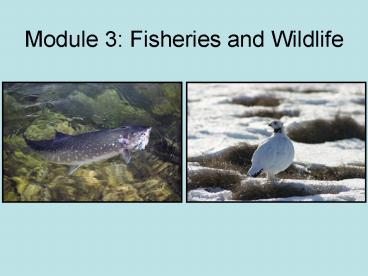Module 3: Fisheries and Wildlife - PowerPoint PPT Presentation
1 / 57
Title: Module 3: Fisheries and Wildlife
1
Module 3 Fisheries and Wildlife
2
Objectives
- Learn about wildlife and fish resources
- Harvesting of wildlife
- Fisheries
- Subsistence vs. commercial activities
- Management and conservation
3
Terms and Concepts
- Sustainable harvest
- The fraction of a wildlife or fish population
that can be harvested without long-term depletion
of the resource (function of age and sex of
harvested animals) - Subsistence fishing/hunting
- The harvest of fish or wildlife as traditional
food
4
Fishing for trout
5
Dried Arctic Char
6
Terms and Concepts
- Management (of fish and wildlife resources)
- Set of regulations to ensure that the harvest is
sustainable and based on conservation principles - Conservation
- Protection of wildlife or fish populations and
their habitats, especially those species
vulnerable to disturbances, industrial
activities, and pollutants
7
Required ReadingBox 39 Polar Bears
8
Important Bird Areas
9
Fragmentation of wild lands
10
A Key Wildlife
- Large herbivores (caribou, muskoxen)
- Important for subsistence hunting and sport
hunting - Important as key herbivores in taiga, tundra, and
Arctic regions
11
Caribou Distribution in North America
12
Caribou in Barren Grounds
13
Caribou in Mountains
14
(No Transcript)
15
Muskox the Arctic Grazer
16
Muskoxen on Bank Island
1985
1994
17
Small Mammals
Arctic Ground Squirrel Spermophilus parryii
Collared Lemming Dicrostonyx torquatus
18
Arctic Ground Squirrel
- Food
- stems, leaves, seeds, fruits, and roots of
grasses, sedges, and other green plants - woody plants
- mushrooms
- stores food (seeds, willow leaves, bog rush
fruit) in burrow for consumption in spring - sometimes preys on collared lemmings and young
snowshoe hares - Habitat
- tundra, subalpine brushy meadows, roadsides,
riverbanks, lakeshores, sandbanks - digs extensive burrow system that may be used for
many years - burrowing can break up vegetation and mix soil
layers, which moves nutrients, changes soil
density, and alters water flow
19
Arctic Ground Squirrel Distribution
20
Arctic Ground Squirrel Distribution
21
Lemmings
- True lemmings (Lemmus spp.)
- Food mosses, grasses and sedges
- Habitat wet lowlands, moist patches
- Collared lemmings (Dicrostonyx spp.)
- Higher cold tolerance than true lemmings
- Food forbs and shrubs (e.g. avens, willows)
- Habitat dry and sandy hills and ridges
- Influence permafrost and nutrient cycling
- At high densities, lemmings graze (remove) much
of the ground vegetation - Allows summer thaw to penetrate deeper in soil
- Warmer soil temperature increases nutrient
availability
22
True Lemming Distribution
23
Collared Lemming Distribution
24
Required ReadingBox 49Lemmings Key Actors
in the Tundra Food Web
25
Large Carnivores for Terrestrial Areas
- Wolves
- Wolverines
- Grizzly Bears
- Foxes
26
(No Transcript)
27
Wolverine Distribution
?
28
(No Transcript)
29
Grizzly Distribution
30
(No Transcript)
31
Arctic fox
32
Game Birds
- Geese
- Sea birds (Conservation Issues)
- Ptarmigans
Snow goose Common eider
33
Raptors
- Eagles
- e.g. Golden, Bald
- Hawks
- e.g. Sharp-shinned, Rough-legged, Red-tailed
- Kites
- e.g. Northern Harrier, Osprey
- Falcons
- e.g. American Kestrel, Merlin, Peregrine Falcon,
Gyrfalcon, - Owls
- e.g. Short-eared, Great Horned, Great Gray,
Snowy, Northern Hawk, Boreal
Rough-legged Hawk
Bald Eagle
34
B Key Fisheries
- Fisheries of Alaska (salmons, pollock, cod, sole)
- Fisheries of anadromous trout (Arctic char,
steelhead) - Marine fisheries (cod, shrimp, navaga, red fish)
35
Alaskas Fisheries
- Dual purposes subsistence, commercial (tourism,
canning, frozen fish) - Commercial seafood industry largest employment
sector - Sport recreational fisheries is increasing
rapidly (conflicts)
36
(No Transcript)
37
(No Transcript)
38
Anadromous Fish
- Life cycle river ? sea ? river
- Mainly char and salmon
- Subsistence, sport, commercial
39
Required ReadingsBox 14 Diversity of Arctic
CharBox 55 Conserving Arctic Char
40
(No Transcript)
41
(No Transcript)
42
Challenges for Commercial Activities
- Sustainability
- Artisan and seasonal
- Transport costs
43
Marine Fisheries
- Productivity
- Central Arctic Basin (deep waters beyond the
continental shelves) is ice-covered all year ?
marine desert - Marginal seas of the Arctic continental shelves
of Eurasia and North America - Water currents drive marine productivity (and
fisheries)
44
Required Reading
- Box 61
- Vent and Seep Communities on the Arctic Seafloor
45
Required Reading
- The Oceans and Seas pg. 183-195
- Spatial variability in productivity
- Temporal variability (within year, among years)
- Role of polynya
46
Where is the Food?
47
Required Reading
- Box 62
- Life Within Sea Ice
48
(No Transcript)
49
(No Transcript)
50
Phytoplankton Around Iceland
51
(No Transcript)
52
Status of Marine Fisheries
53
(No Transcript)
54
Tough to Manage Fisheries
55
One More CollapseAgain
56
(No Transcript)
57
Box 68































